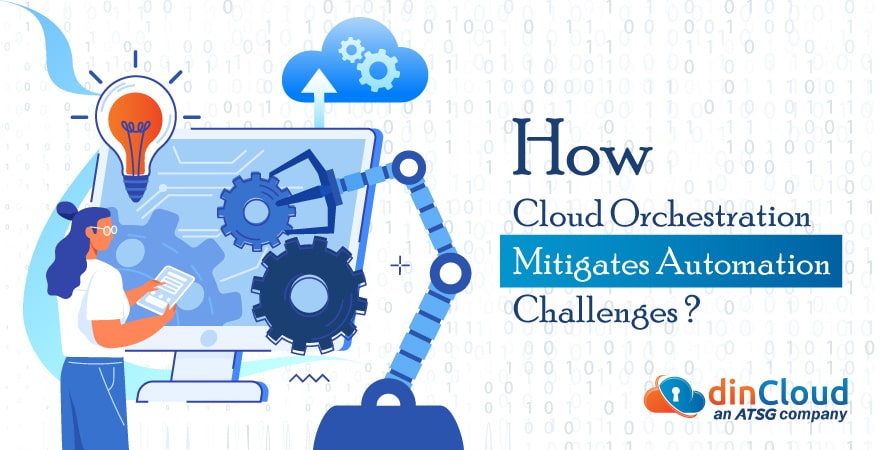In today’s digitally dominated marketplace, the notion to prosper and evolve has become a business necessity.
Recently, we have witnessed an increasing number of multi-Cloud environments making their way into mainstream business operations. Although heterogeneous Cloud environments offer limitless opportunities to enterprises, they also accompany their fair share of challenges for IT infrastructures.
As enterprises deploy more Cloud platforms, complexity increases, and integration challenges as well as redundancy issues emerge too. This is where Cloud orchestration comes in the picture, to resolve these bottlenecks and achieve the desired outcomes in a seamless manner.

Cloud Orchestration Explained
By now, it has become a well-established fact that with Cloud Computing technologies, enterprises do not have to worry about IT hardware-related high up-front costs, or constant maintenance overheads. Cloud-based solutions give enterprises the confidence to scale their compute and storage resources, up or down, as per their varying requirements.
Even though scalability is a strong selling point for Cloud Computing solutions, enterprises need to be mindful of deploying the right software programs, which seamlessly run on their IT environments. Here, Cloud orchestration plays a huge role through its automation and customization abilities.
Cloud orchestration is the process of utilizing codes and configuration files to effectively handle enterprises’ core IT environments and workflows. It involves cohesion and unification of independent automation processes and systems, to manage and secure IT infrastructures.
For instance, Cloud orchestration mostly manages the application lifecycle, which involves acquiring storage compute resources, Operating System (OS) configurations and the deployment of applications. In a nutshell, Cloud orchestration streamlines numerous workloads into a single workflow through automation.
Difference Between Cloud Automation and Cloud Orchestration
Cloud orchestration is an all-encompassing domain, which includes Cloud automation as its subset. The following points will clarify the difference between the two processes.
- In order to attain high workflow goals, various automation tasks are handled by Cloud orchestration systems. Cloud automations, on the other hand, perform repetitive tasks, like network configuration on new Virtual Machines (VM).
- Numerous inter-connected automation processes are managed by Cloud orchestration for the purpose of creating dynamic workflows.
- The security of automation tasks is managed via Cloud orchestration. However, policy decisions that are outside the Operating System’s (OS) Access Control List (ACL), cannot be altered in Cloud automation processes.
- Cloud automation is not concerned with the utilization of resources, beyond its specific domain, whereas Cloud orchestration works towards the effective utilization of all the Cloud-based resources and reduces over-provisioning.
Importance of Cloud Orchestration
With the popularity of micro-services, the dependency on automation for repetitive tasks / workloads has increased manifolds. When it comes to handling these complex tasks at scale, enterprises need tools, policies, monitoring skills and visualizations.
Manual interventions and ad-hoc infrastructures can no longer suffice to deal with the complexities of such automations. Therefore, Cloud orchestration acts as a key enabler for businesses’ long-term stability.
Cloud orchestration decreases the need for constant human intervention, and helps enterprises in the following ways.
- Reduced chances of human error save the time, efforts and money of the deploying enterprises.
- For improved security, Cloud orchestration systems make sure that only legitimized users can access and modify automation systems.
- A generalized infrastructure is developed to ensure that the addition of new automation tasks does not require other specialized tools.
- A cloud orchestration system also provides a robust diagnostic support system, and effective de-bugging capabilities.
A leading Cloud Service Provider (CSP), dinCloud, offers its transparent and easy to use Cloud orchestration platform, dinManage. It comes with a wide range of security options, like Two-Factor Authentication (2FA). With dinManage, users can have full visibility and control over the management of their Cloud-based environment (servers, storage capacity, desktops and multiple applications).
What Are Cloud Orchestration Tools?
Enterprises often operate in diverse computing environments, and it is vital to minimize overheads and friction regarding workload automation. Cloud orchestration tools help businesses achieve this, while keeping the security protocols intact.
In this section, we have listed the characteristics of robust Cloud orchestration solutions.
- They should be able to manage job dependencies and complex tasks in an effective manner.
- Effective Cloud orchestration solutions are adaptable and flexible to manage diverse IT infrastructures.
- They should be able to ensure optimal utilization of resources.
- Cloud orchestrations must bridge the gap between public and private cloud infrastructures.
- Application Programming Interfaces (APIs) should be flexible, so that data export and interactions with external applications is seamless.
- Users having various technical abilities should be able to operate them through effective management tools, and scheduling of workflows.
Conclusion
Cloud orchestration plays a key role in the realm of Cloud Computing technologies. Today’s heterogeneous multi-Cloud environments require the latest Cloud orchestration approach, which can effectively coordinate automations and enable rapid scaling.
The most suitable analogy would be like playing an orchestra. Just like the conductor of an orchestra, Cloud orchestration also involves coordinating various movements, setting the tempo to keep all the Cloud environments in sync, and making sure that everything is running in harmony.
dinCloud, an ATSG company, offers scalable Cloud-based solutions for your enterprise needs, along with its in-house Cloud orchestration portal, dinManage. dinManage allows users to handle their entire Cloud environment and perform multiple tasks, all from a single, user-friendly and intuitive interface.


